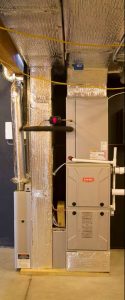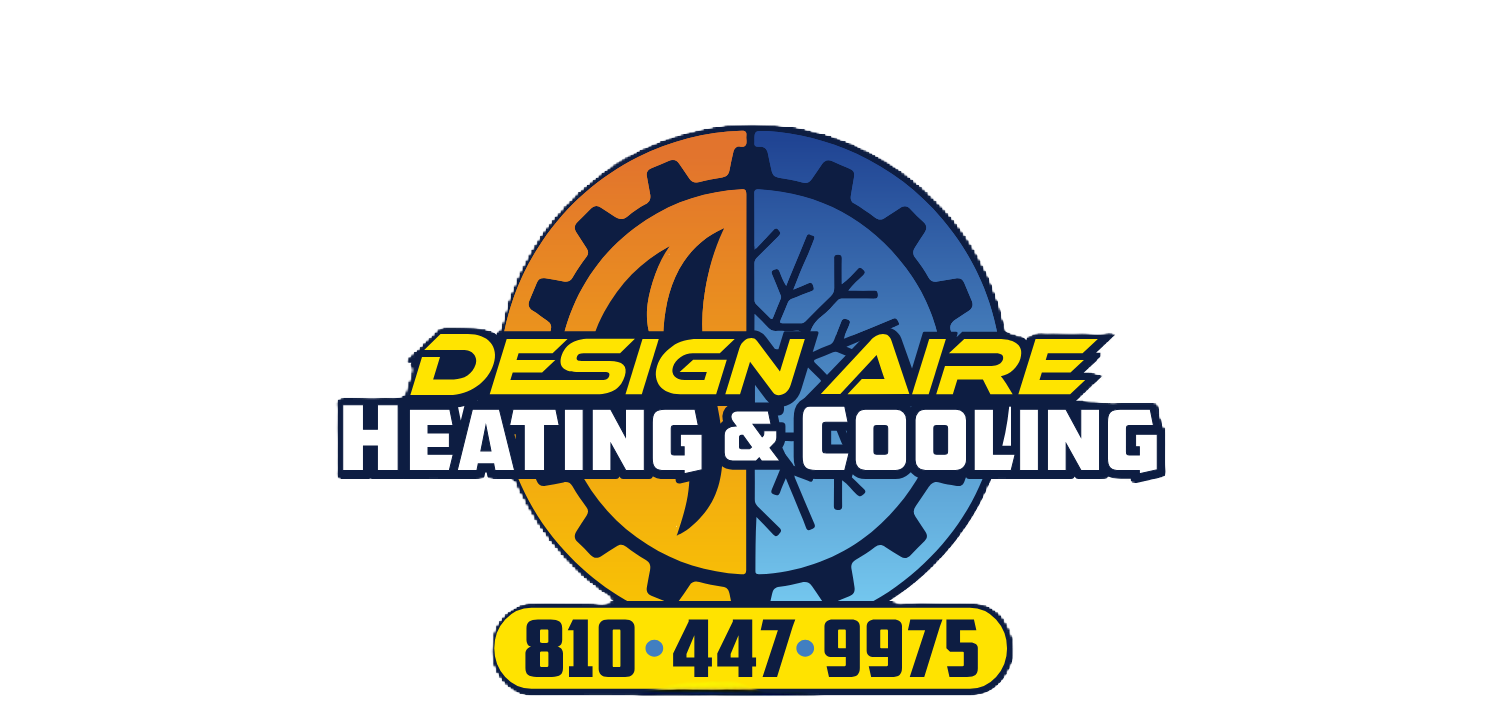Open 24/7 CALL US AT (810) 447-9975
We Have You Covered For All Your Heating Needs
10% Off First Time Customers On Any Repairs!!
Heating Repairs In Howell, MI

When the Michigan winter hits, a malfunctioning furnace can quickly turn your comfortable home into a chilly and uncomfortable space. Design Aire understands the urgency and frustration of furnace breakdowns, and we’re dedicated to providing prompt, reliable, and expert furnace repair services to homeowners throughout the region. Our team of highly trained and certified technicians is equipped to handle any furnace issue, restoring your home’s warmth and comfort efficiently.
Why Choose Design Aire for Your Furnace Repairs?
At Design Aire, we believe in providing more than just quick fixes. We strive to deliver comprehensive solutions that address the root cause of your furnace problems, ensuring long-lasting performance and peace of mind. Here’s what sets us apart:
- Expert Technicians: Our technicians are NATE-certified and undergo continuous training to stay up-to-date with the latest furnace technologies and repair techniques. They possess the knowledge and skills to diagnose and repair all makes and models of furnaces.
- Prompt and Reliable Service: We understand that furnace breakdowns can happen at any time, especially during the coldest nights. That’s why we offer fast and reliable service, prioritizing your comfort and safety.
- Transparent Pricing: We believe in honest and upfront pricing. Before any work begins, we’ll provide you with a detailed estimate, so you know exactly what to expect. No hidden fees or surprises.
- Comprehensive Diagnostics: We don’t just guess at the problem. Our technicians use advanced diagnostic tools to pinpoint the exact cause of your furnace malfunction, ensuring accurate and effective repairs.
- Quality Parts: We use only high-quality, manufacturer-approved parts for all our repairs, ensuring optimal performance and longevity of your furnace.
- Safety First: We prioritize safety in every repair we perform. We adhere to strict safety protocols and ensure all repairs are completed to the highest standards.
- Local Expertise: As a Michigan-based company, we understand the unique heating challenges faced by homeowners in our region. We’re familiar with the specific needs of our local climate and can provide tailored solutions.
- Customer Satisfaction Guarantee: We stand behind our work and are committed to your complete satisfaction. If you’re not happy with our service, we’ll do everything we can to make it right.
Common Furnace Problems We Repair:
Our technicians are experienced in repairing a wide range of furnace issues, including:
- Pilot light or ignition problems
- Faulty thermostats
- Blower motor malfunctions
- Gas valve issues
- Heat exchanger cracks
- Clogged filters
- Strange noises or odors
- Uneven heating
- Frequent cycling
Our Furnace Repair Process:
When you call Design Aire for furnace repairs, you can expect a streamlined and efficient process:
- Schedule an Appointment: Contact us to schedule a convenient appointment time.
- Diagnostic Assessment: Our technician will arrive on time and conduct a thorough diagnostic assessment of your furnace.
- Detailed Explanation and Estimate: We’ll explain the problem and provide you with a detailed estimate for the repairs.
- Professional Repair: Our technician will perform the necessary repairs using high-quality parts.
- System Testing: We’ll thoroughly test your furnace to ensure it’s operating correctly and safely.
- Customer Satisfaction: We’ll ensure you’re completely satisfied with our service before we leave.
Don’t let a malfunctioning furnace leave you in the cold. Contact Design Aire today for fast, reliable, and expert furnace repair services. We’re here to restore your home’s warmth and comfort, ensuring you stay cozy throughout the Michigan winter.
Are You Having Issues with Your Furnace Call Us Today! (810) 447-9975
Common Causes for A furnace Failure
1. Dirty or Clogged Air Filters:
- In-Depth Explanation:
- Air filters are the first line of defense against airborne particles like dust, pet dander, and pollen. When these particles accumulate, they restrict airflow through the furnace.
- This restriction forces the blower motor to work harder to circulate air, leading to increased strain and potential overheating.
- Overheating can damage critical components such as the heat exchanger, blower motor, and limit switch, resulting in costly repairs or premature furnace failure.
- Furthermore, restricted airflow reduces the furnace’s efficiency, causing it to consume more energy to achieve the desired temperature, leading to higher utility bills.
- In extreme cases, a severely clogged filter can trigger the furnace’s safety mechanisms, shutting it down to prevent overheating and potential fire hazards.
- Preventative Measures:
- Regularly inspect and replace or clean air filters according to the manufacturer’s recommendations, typically every 1-3 months, or more frequently during periods of heavy use.
2. Thermostat Malfunctions:
- In-Depth Explanation:
- The thermostat acts as the control center of your heating system, regulating the furnace’s operation based on the desired temperature.
- Malfunctions can arise from various factors, including:
- Dead or weak batteries (for battery-powered thermostats).
- Loose or corroded wiring connections.
- Faulty sensors or internal components that misread the room temperature.
- Calibration errors that cause the thermostat to display inaccurate readings.
- These malfunctions can lead to:
- The furnace failing to turn on when needed.
- The furnace cycling on and off excessively (short cycling), which reduces efficiency and increases wear and tear.
- Inconsistent heating, resulting in uncomfortable temperature fluctuations.
- Preventative Measures:
- Regularly check and replace thermostat batteries.
- Ensure proper wiring connections and consider having a qualified technician inspect and calibrate the thermostat.
3. Ignition System Issues:
- In-Depth Explanation:
- Gas furnaces rely on an ignition system to ignite the gas and produce heat.
- Older furnaces use a pilot light, while newer models use electronic ignition (spark igniters or hot surface igniters).
- Common ignition problems include:
- A dirty or faulty flame sensor, which detects the presence of a flame and ensures safe operation.
- A malfunctioning igniter that fails to produce a spark or heat.
- A blocked gas valve that prevents gas from flowing to the burner.
- A weak or extinguished pilot light due to drafts or gas supply issues.
- These issues prevent the furnace from igniting, resulting in a lack of heat.
- Preventative Measures:
- Regularly inspect and clean the flame sensor.
- Have a qualified technician inspect and maintain the ignition system annually.
4. Heat Exchanger Cracks:
- In-Depth Explanation:
- The heat exchanger is a vital component that separates the combustion gases from the air circulating in your home.
- Cracks can develop due to:
- Repeated expansion and contraction from heating cycles.
- Overheating caused by restricted airflow or other malfunctions.
- Corrosion from moisture or condensation.
- A cracked heat exchanger is a serious safety hazard, as it can leak carbon monoxide into your home, posing a significant health risk.
- Preventative Measures:
- Regularly inspect the heat exchanger for cracks or damage.
- Ensure proper airflow by maintaining clean air filters.
- Have a professional perform annual inspections.
5. Blower Motor Failure:
- In-Depth Explanation:
- The blower motor is responsible for circulating heated air throughout your home’s ductwork.
- Failure can occur due to:
- Worn bearings or other mechanical components.
- Electrical problems, such as faulty wiring or a blown capacitor.
- Overheating caused by restricted airflow.
- A failing blower motor can result in:
- No airflow or weak airflow from the vents.
- The furnace overheating and shutting down.
- Uneven heating throughout the home.
- Preventative Measures:
- Regularly lubricate the blower motor as needed.
- Ensure proper airflow by maintaining clean air filters.
- Have a qualified technician inspect and maintain the blower motor.
6. Limit Switch Problems:
- In-Depth Explanation:
- The limit switch is a safety device that monitors the furnace’s temperature and shuts it down if it overheats.
- Malfunctions can occur due to:
- Electrical problems.
- Wear and tear.
- Overheating caused by restricted airflow.
- A faulty limit switch can cause:
- The furnace to shut down prematurely.
- The furnace to cycle on and off excessively.
- The furnace to fail to turn on at all.
- Preventative Measures:
- Ensure proper airflow by maintaining clean air filters.
- Have a qualified technician inspect and test the limit switch annually.
7. Wear and Tear/Age:
- In-Depth Explanation:
- Like any mechanical system, furnaces have a limited lifespan.
- Over time, components wear out, become corroded, or develop cracks due to repeated heating cycles.
- Most furnaces have a lifespan of 15-20 years.
- As furnaces age, they become less efficient and more prone to breakdowns.
- Preventative Measures:
- Schedule regular maintenance to extend the furnace’s lifespan.
- Consider replacing the furnace if it is nearing or exceeding its expected lifespan.
- Keep an eye and ear out for unusual noises, or performance changes.
Heating Repairs FAQs
Signs include strange noises, uneven heating, increased energy bills, frequent cycling, and a yellow pilot light (if applicable).
Factors to consider include the furnace’s age, repair costs, and energy efficiency. If it’s old and repairs are costly, replacement might be more economical.
Noises like banging, rattling, or grinding can indicate problems with the blower motor, fan, or other components.
This “short cycling” can be caused by a dirty filter, a faulty limit switch, or an oversized furnace.
Annual maintenance is recommended to ensure optimal performance and prevent breakdowns.
They detect the presence of carbon monoxide, a colorless, odorless, and deadly gas. They are essential for safety, especially with gas furnaces.
